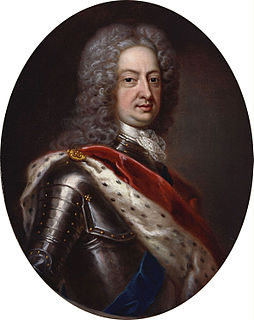
Sophia of Hanover was the Electress of Hanover by marriage to Elector Ernest Augustus, and later the heiress presumptive to the thrones of England and Ireland under the Act of Settlement 1701. She died less than two months before she would have become queen. Consequently, it was her son George I who succeeded her first cousin once removed, Anne.

Chess or the King's Game is a book on chess. It was published in Leipzig in 1616 under the name of Gustavus Selenus, the pen name of Duke Augustus of Brunswick-Lüneburg (1579–1666). As a young prince, Augustus probably had learned of the game during his voyages to Italy and purchased numerous chess books from the Augsburg merchant and art collector Philipp Hainhofer. The first textbook on chess in the German language, the work is mainly based on the Libro de la invencion liberal y arte del juego del axedrez written in 1561 by the Spanish priest Ruy López de Segura, but also contains extensive philosophical and historical considerations.

The House of Hanover, whose members are known as Hanoverians, is a German royal house that ruled Hanover, Great Britain, and Ireland at various times during the 17th to 20th centuries. The house originated in 1635 as a cadet branch of the House of Brunswick-Lüneburg, growing in prestige until Hanover became an Electorate in 1692. George I became the first Hanoverian monarch of Great Britain and Ireland in 1714. At Queen Victoria's death in 1901, the throne of the United Kingdom passed to her eldest son Edward VII, a member of the House of Saxe-Coburg and Gotha. The last reigning members of the House lost the Duchy of Brunswick in 1918 when Germany became a republic.

The Duchy of Brunswick-Lüneburg, or more properly the Duchy of Brunswick and Lüneburg, was a historical duchy that existed from the late Middle Ages to the Late Modern era within the Holy Roman Empire, until the year of its dissolution. The duchy was located in what is now northwestern Germany. Its name came from the two largest cities in the territory: Brunswick and Lüneburg.

The Principality of Calenberg was a dynastic division of the Welf duchy of Brunswick-Lüneburg established in 1432. Calenberg was ruled by the House of Hanover from 1635 onwards; the princes received the ninth electoral dignity of the Holy Roman Empire in 1692. Their territory became the nucleus of the Electorate of Hanover, ruled in personal union with the Kingdom of Great Britain from 1714 onwards. The principality received its name from Calenberg Castle, a residence of the Brunswick dukes.

The House of Welf is a European dynasty that has included many German and British monarchs from the 11th to 20th century and Emperor Ivan VI of Russia in the 18th century.
Hanover is a territory that was at various times a principality within the Holy Roman Empire, an Electorate within the same, an independent Kingdom, and a subordinate Province within the Kingdom of Prussia. The territory was named after its capital, the city of Hanover, which was the principal town of the region from 1636. In contemporary usage, the name is only used for the city; most of the historical territory of Hanover forms the greater part of the German Land of Lower Saxony but excludes certain areas.

Nathaniel Cooke was the designer of a set of chess figures which is now the standard set.

Schachdorf Ströbeck is a village in Saxony-Anhalt, Germany, which since 1 January 2010 is part of the town of Halberstadt in the Harz district, in Saxony-Anhalt, Germany. Located about 8 km (5.0 mi) west of the city centre, the Schachdorf is known for its long historic connection with chess.

The Duchy of Brunswick was a historical German state. Its capital was the city of Brunswick (Braunschweig). It was established as the successor state of the Principality of Brunswick-Wolfenbüttel by the Congress of Vienna in 1815. In the course of the 19th-century history of Germany, the duchy was part of the German Confederation, the North German Confederation and from 1871 the German Empire. It was disestablished after the end of World War I, its territory incorporated into the Weimar Republic as the Free State of Brunswick.

Ernst August, Hereditary Prince of Brunswick, Prince of Hanover was head of the House of Hanover from 1953 until his death. From his birth until the German Revolution of 1918–1919 he was the heir apparent to the Duchy of Brunswick, a state of the German Empire.

A chess set has thirty-two chess pieces in two colours and a chessboard used to play chess. Chess is played by two players, each starting with one king, one queen, two rooks, two bishops, two knights and eight pawns. Chess equipment often accompanying a chess set are a chess box, chess clock and chess table. Chess sets are made in a wide variety of styles, often for ornamental rather than practical purposes. For tournament play, the Staunton chess set is preferred or required.

Augustus II, called the Younger, a member of the House of Welf was Duke of Brunswick-Lüneburg. In the estate division of the House of Welf of 1635, he received the Principality of Wolfenbüttel which he ruled until his death. Considered one of the most literate princes of his time, he is known for founding the Herzog August Library at his Wolfenbüttel residence, then the largest collection of books and manuscripts north of the Alps.

Ernest Augustus, Duke of York and Albany, was the younger brother of George I of Great Britain. Ernest Augustus was a soldier and served with some distinction under Emperor Leopold I during the Nine Years' War and the War of the Spanish Succession. In 1715, he became Prince-Bishop of Osnabrück.

The Herrenhausen Gardens of Herrenhausen Palace, located in Herrenhausen, an urban district of Lower Saxony's capital of Hanover are made up of the Great Garden, the Berggarten, the Georgengarten and the Welfengarten. The gardens are a heritage of the Kings of Hanover.

Jaques of London, formerly known as John Jaques of London and Jaques and Son of London is a long-established family company that manufactures sports and game equipment.

The Staunton chess set is composed of a particular style of chess pieces used to play the game of chess. According to the rules of chess, this style is to be used for competitions. The journalist Nathaniel Cooke is credited with the design, and they are named after the English chess master Howard Staunton. The first 500 sets were hand signed and numbered by Staunton. This style of set was first made available by Jaques of London in 1849, and they quickly became the standard. They have been used around the world since.
Courier chess is a chess variant that dates from the 12th century and was popular for at least 600 years. It was a part of the slow evolution towards modern chess from Medieval Chess.

The Principality of Brunswick-Wolfenbüttel was a subdivision of the Duchy of Brunswick-Lüneburg, whose history was characterised by numerous divisions and reunifications. Various dynastic lines of the House of Welf ruled Brunswick-Wolfenbüttel until the dissolution of the Holy Roman Empire in 1806. As a result of the Congress of Vienna, its successor state, the Duchy of Brunswick, was created in 1815.

The House of Staunton (HOS) is an Alabama-based company founded by Frank Camaratta in 1990 that manufactures chess pieces, chessboards, and chess boxes.
















